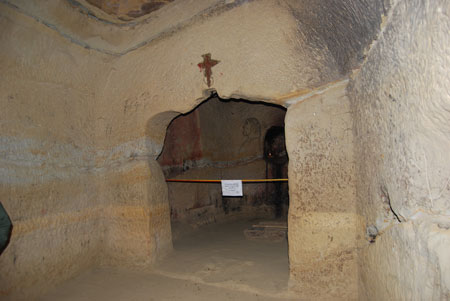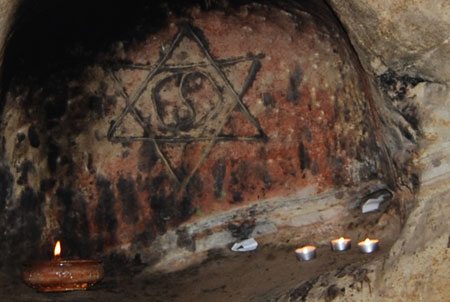Mihai came round early on Sunday
morning to take me out with a couple of his boxing friends -- big bald men who
filled the car very amply -- and we set off. Finally, I got the hang of male friendships. Men are good chaps and, if not as interesting
as women or as good at conversation, just as intelligent.
Mihai said we were going to Fagaras, and I thought he meant the town, where I never was, but in fact we were going to Sinca Veche, twenty-eight miles from Brasov and fourteen from Fagaras. I am ashamed that I had never heard of it.
Sinca Veche is notable for its (former) monastery which is in fact not recognisable as a monastery but is a cave (or grotto) cut out of chalk. Before it was consecrated by Christians (who built the two small altars or shrines which stand in the middle of the cave-monastery) it was a prehistoric temple which locals say is seven thousand years old. You enter it through a tunnel cut from the chalk. Light enters from above, through a hole in the chalk. The hole was constructed in such a way that the sun shines straight into the temple on the vernal and autumnal equinoxes. It is a kind of Transylvanian Stonehenge.
Mihai, the very learned amateur archaeologist, tells me that chalk cannot be carbon dated and so there is no way of telling the age of the carvings on the walls. This pleases me. The Star of David ,is carved on the wall and inside it are the ying and yang symbols, though no-one knows who built it or why. In W.H.Auden's words, it was all so unimaginably long ago. Long before the Emperor Trajan conquered Dacia, or before prehistoric property developers began building on the seven hills of Rome, Sinca Veche was already ancient. Or at least it is presumed so, because we do not know for sure.
Mihai said we were going to Fagaras, and I thought he meant the town, where I never was, but in fact we were going to Sinca Veche, twenty-eight miles from Brasov and fourteen from Fagaras. I am ashamed that I had never heard of it.
Sinca Veche is notable for its (former) monastery which is in fact not recognisable as a monastery but is a cave (or grotto) cut out of chalk. Before it was consecrated by Christians (who built the two small altars or shrines which stand in the middle of the cave-monastery) it was a prehistoric temple which locals say is seven thousand years old. You enter it through a tunnel cut from the chalk. Light enters from above, through a hole in the chalk. The hole was constructed in such a way that the sun shines straight into the temple on the vernal and autumnal equinoxes. It is a kind of Transylvanian Stonehenge.
Mihai, the very learned amateur archaeologist, tells me that chalk cannot be carbon dated and so there is no way of telling the age of the carvings on the walls. This pleases me. The Star of David ,is carved on the wall and inside it are the ying and yang symbols, though no-one knows who built it or why. In W.H.Auden's words, it was all so unimaginably long ago. Long before the Emperor Trajan conquered Dacia, or before prehistoric property developers began building on the seven hills of Rome, Sinca Veche was already ancient. Or at least it is presumed so, because we do not know for sure.


In fact, the whole place, as well as the little valley in which the cave sits, and the plateau above the cave, are filled with the most extraordinary peace and sense of spirituality. Whether this feeling is Christian or pre-Christian, I do not know, but I suspect the latter.
Sinca Veche is in Transylvania, which was for nine hundred years till 1919 part of Hungary, but close to the Wallachian border, which runs along the Carpathian Mountains. In other words, close to the border between the Near East and the furthest redoubt of Catholic Europe. When the Orthodox Church was being persecuted by the government of the Empress Maria Theresa, Orthodox priests hid in this place.
Locals call it the Temple of Fate, believing that the place has a powerful energy, and that if you pray here your prayers will be answered. Romania has been Christian for a very long time, even if she probably was not converted by the apostle St. Andrew, but it is hard to believe that these beliefs are not very much older than Christianity. Iris Murdoch said that Protestants let too much light in on mystery. A great deal of light floods into the monastery or temple at Sinca Veche but it does nothing to illuminate the deep, palpable mystery of the place.
The feeling of calm is something you find much more often in Romania than other countries but it reminded me, in particular, of the grotto of St. Andrew, near the village of Ion Corvin in Dobrudgea, on the way from Bucharest to Constanta, to which Mihai also took me on another occasion. The apostle is supposed, on very flimsy evidence, to have taken shelter there. The older and newer churches by the grotto are not attractive but the grotto, for some reason, is moving, and the setting itself has a remarkable feeling of heavenly calm. There are more things in heaven and earth than are dreamt of in our philosophy.
The journey to Sinca Veche and the exploration of this sacred place had made me very hungry. We set off in the direction of Fagaras to get some lunch but had a very pleasant surprise on the way: a newly built touristic complex nearby called Inexdor, which was empty in preparation for a wedding party later on, but which nevertheless was able to rustle up a good lunch for us. We all thought the food - simple Romanian dishes - was excellent and I believe it was good value -- although for some reason I was not allowed to contribute to the bill; yes, these burly, bald, fighting men were, indeed, good chaps. We said we would go back for a weekend and I look forward to it.
And finally to make the day perfect we altered our return route and came back on the most magical road in the world, as far as I know at least: the Transfagaras Highway, with its fifty miles of dizzying twists and turns. It is a road that only a dictatorship could have built -- for dictatorships can be extravagant with manual labour -- and this road was built by Ceausescu for defensive purposes. Not, of course, to defend Romania from attack by NATO, which was never a possibility, but from her ally the Soviet Union. Compounding the beauty of the abysses and mountains, there is also the Vidraru Dam and Reservoir to admire, as well as the wonderfully dramatic Poienari Castle, perched on a crag, and built by that famous builder and disciplinarian, Vlad the Impaler, who is always identified rather inexactly with Dracula.
The journey to Sinca Veche and the exploration of this sacred place had made me very hungry. We set off in the direction of Fagaras to get some lunch but had a very pleasant surprise on the way: a newly built touristic complex nearby called Inexdor, which was empty in preparation for a wedding party later on, but which nevertheless was able to rustle up a good lunch for us. We all thought the food - simple Romanian dishes - was excellent and I believe it was good value -- although for some reason I was not allowed to contribute to the bill; yes, these burly, bald, fighting men were, indeed, good chaps. We said we would go back for a weekend and I look forward to it.
And finally to make the day perfect we altered our return route and came back on the most magical road in the world, as far as I know at least: the Transfagaras Highway, with its fifty miles of dizzying twists and turns. It is a road that only a dictatorship could have built -- for dictatorships can be extravagant with manual labour -- and this road was built by Ceausescu for defensive purposes. Not, of course, to defend Romania from attack by NATO, which was never a possibility, but from her ally the Soviet Union. Compounding the beauty of the abysses and mountains, there is also the Vidraru Dam and Reservoir to admire, as well as the wonderfully dramatic Poienari Castle, perched on a crag, and built by that famous builder and disciplinarian, Vlad the Impaler, who is always identified rather inexactly with Dracula.
My companions, whom I would certainly want on my side in the case of a bar fight, and I agreed that the excursion was as fine a way to fill a day as one could ever imagine.
To contact the Inexdor touristic complex, which does not have a site, call 0040-727-200 670 or 0040-760 185 912.



Hello,
ReplyDeleteSinca Veche is the village where I grew up. Indeed, this village has a charm that makes you come back. The fresh air and the surroundings are beautiful. This village rich in history, often unwritten unfortunately, holds many wonderful stories. I invite you to the next visit to Sinca Veche to contact me and I will be more than happy to do a tour of the village.
Website Sinca Veche village - www.sinca-veche.ro - you can find my contact information.
Best wishes,
Gabriel Pioaru
Sarah writes about Sinca Veche here.http://sarahinromania.canalblog.com/archives/2014/09/05/30533686.html#c62935922
ReplyDelete